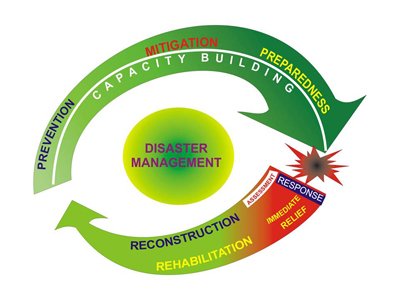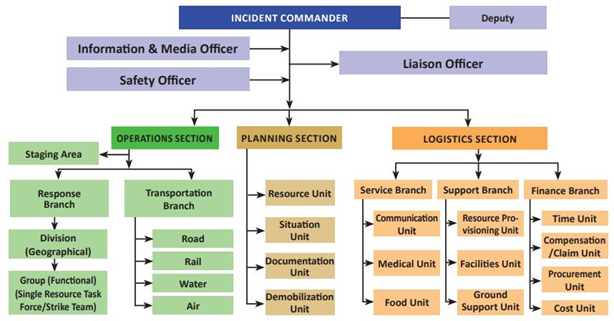DISASTER MANAGEMENT IN INDIA-HISTORY & CAPACITY BUILDING
INTRODUCTION
In India, disaster management is mainly related to conservation of lives and property during natural and man-made disaster. India is prominently vulnerable to natural disaster due to its unique Geo-climatic condition.
VULNERABILITY– India is vulnerable, in varying degrees to a large number of disasters. More than 58.6 per cent of the landmass is prone to earthquakes of moderate to very high intensity; over 40 million hectares (12%) of its land is prone to floods and river erosion; close to 5,700 kms, out of the 7,516 kms long coastline is prone to cyclones and tsunamis; 68% of its cultivable area is vulnerable to droughts; and, its hilly areas are at risk from landslides and avalanches.
Moreover, India is also vulnerable to Chemical, Biological, Radiological and Nuclear (CBRN) emergencies and other man-made disasters.
HISTORY
- The Government of India set up a High-Powered Committee in August 1999 and a National Committee after the Gujarat earthquake, for making recommendations on the preparation of Disaster Management plans and suggesting effective mitigation mechanisms.
- On 23 December 2005, the Government of India enacted the Disaster Management Act, which envisaged the creation of National Disaster Management Authority (NDMA), headed by the Prime Minister, and State Disaster Management Authorities (SDMAs) headed by respective Chief Ministers, with the vision “to build a safer and disaster resilient India by a holistic, pro-active, technology driven and sustainable development strategy that involves all stakeholders and fosters a culture of prevention, preparedness and mitigation.”
- Thus NDMA has following responsibilities in India-
- Lay down policies on disaster management and Approve the National Plan prepared by Departments of the Government of India in accordance with the National Plan,
- Lay down guidelines to be followed by the different Ministries or Departments of the GOI for the Purpose of integrating the measures for prevention of disaster or the mitigation of its effects in their development plans and projects,
- Coordinate the enforcement and implementation of the policy and plans for disaster management,
- Take such other measures for the prevention of disaster, or the mitigation, or preparedness and capacity building for dealing with threatening disaster situations or disasters as it may consider necessary.

CAPACITY BUILDING BY NDMA
- The Incident Response System (IRS) – It is an effective mechanism for reducing ad-hoc measures in response. It envisages a composite team with various Sections to attend to all the possible response requirements. As illustrated in the figure below, The Operations Section helps to prepare and execute different tactical operations required in response to the disaster. The Planning Section helps in obtaining information and preparing plans as required. The Logistics Section assesses the availability and requirement of resources and takes action for obtaining them. IRTs will function at State, District, Sub-Division and the Tehsil / Block levels. The IRTs will be pre-designated at these levels and on receipt of Early Warning; the corresponding Responsible Officer will activate them. In case a disaster occurs without any warning, the local IRT will respond and contact the Responsible Officer for further support, if required.

2. Civil Defence- Civil Defence measures are designed to deal with immediate emergency conditions, protect the public and restore vital services and facilities that have been destroyed or damaged by disaster. The objectives of Civil Defence are to save the life, to minimize loss of property, to maintain continuity of production and to keep high up the morale of the people. During times of war and emergencies, the Civil Defence organization has the vital role of guarding the hinterland, supporting the Armed forces, mobilizing the citizens and helping civil administration.
3. Fire Service– fire service in India, broadly is extinguishing fire and protecting life and property in case of fire. The fire service now responds to hazardous material incidents, advanced emergency medical situations, high angle rescue and confined space rescue incidents, trench and collapse operations, underwater rescue and more
4. Mock exercise- NDMA, in coordination with vulnerable States, took the initiative of conducting Mock Exercises on various types of natural and manmade disasters. This has also helped in inculcating a culture of preparedness and generated awareness.
5. Trauma center– NDMA has taken concerted steps to enhance preparedness in this important domain in partnership with the Ministry of health and Family Welfare and State Governments. Some projects like improving Ambulance Services in the State, up-gradation of Bio Safety Laboratories and creation of Trauma Centers are in the offing.
6. Psycho-social Care- It refers to comprehensive interventions aimed at addressing a wide range of psycho-social and mental health problems arising in the aftermath of disasters. These interventions help individuals, families and groups to build human capacities, restore social cohesion and infrastructure along with maintaining their independence, dignity and cultural integrity. (Source-NDMA)
Read more…
WHAT IS DISASTER- MEANING & TYPES
WHAT IS DISASTER MANAGEMENT
ESSAY ON ENVIRONMENTAL POLLUTION
WHAT IS EUTROPHICATION-MECHANISM, CONSEQUENCES & CONTROL